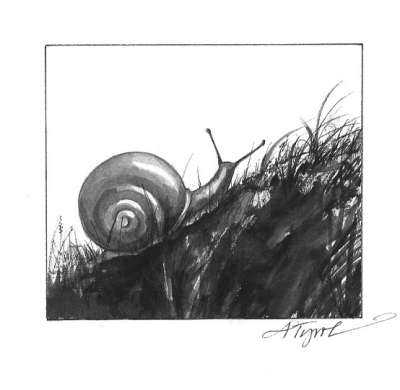
A rainy day for a snail is equivalent to a beautiful day at the beach for us, which might just explain why our moisture-loving land snails were out and about in greater numbers this summer. Still, even with this year’s jump in snail sightings, we are only seeing the tip of the tentacle.
Of the 100 species of land snails in our area, only about a dozen are big enough to be noticed. Even the whitelip (Triodopsis albolabris), the largest of the shelled New England land snails at a little over 1.25” in diameter, is easy to overlook and wouldn’t seem at first glance to be an ecological lynchpin. But this handsome snail and its relatives are important players in such varied processes as wood thrush reproduction, the return of the moose, and the annual June firefly show.
Some of these roles revolve around the element calcium. A snail shell is made of calcium carbonate thinly coated with protein. To make its shell, a snail gathers calcium either from its food or directly from the soil by absorbing it through its foot. In general, areas with more available calcium will have more land snail species. In fact, geologists use the presence of snails as indicators of carbonate-containing bedrock. In our region, sugar maple grows well over such bedrock, and every part of the tree is quite high in calcium (its leaf litter is almost 2 percent calcium by dry weight), so a good place to look for snails is on rotting sugar maple logs.
Snails are food for a wide range of predators because snails offer more than just the calories in their bodies – they have those calcium-rich shells, too. Calcium is an essential nutrient for all animals, and one of special importance for egg-layers. In Europe, a correlation has been shown between reduced soil calcium due to acid rain, thinning of great tit eggshells, and declining populations of the land snails that the birds feed on. There is concern that something similar might be happening to our wood thrushes, which are declining in areas subject to acid rain. Thrushes eat snails, shell and all.
Smaller predators have found a way around, or through, the protection that a snail’s shell provides. Cychrinid beetles have long, narrow heads that can slip easily into a shell. Firefly larvae follow snail slime trails, inject a paralyzing poison into the snail’s body, and then feed on the immobilized snail. There are even land snails that eat other land snails. The gray-foot lancetooth (Haplotrema concavum) will chase and overtake another snail before using its file-like tongue to wear a hole in its victim’s shell and rasp out the body.
In one sense, these tiny animals can even fell the mighty moose. The deer brainworm, a parasite of white-tailed deer, lives in snails for part of its lifecycle. The snails are attracted to and feed on deer droppings containing tiny parasite larvae. After entering through the snail’s foot, the larvae develop into a form that can re-infect deer or other related species if the snail is accidentally eaten. Although not lethal to deer, the brainworm can infect, and usually kills, moose. There is disagreement about whether or not a high deer population leads to a decline in moose numbers because of this parasite – the research observations so far are contradictory and inconclusive.
A snail’s slimy trail is certainly one of its most noticeable traits and has several functions. Slime is secreted by the snail’s foot and provides a slippery gliding surface. It protects the foot from sharp objects: a snail can crawl over a razor blade unharmed. Slime puts off predators: anyone with a garden knows how hard it is to get a firm grip on a slug. And because slime hardens upon exposure to air, it can plug a snail shell shut or glue it against a rock to prevent predation or to slow dehydration. Snail slime also contains an antibiotic and is an ingredient in some acne medicines.
How snails make more snails is often a genteel affair, preceded by a courtship that may take hours and include various crawling and touching behaviors. Almost all snails and slugs are hermaphrodites: each individual produces both sperm and eggs. Fertilization is internal, and usually two do this tango, with each individual inserting a sperm packet into the other via a single opening that is visible just behind the right eye tentacle. Apparently the whitelip can fertilize itself, a possible advantage for a slow-moving animal with small, scattered populations.
So did our rainy summer give our land snails that certain glow, that wild and crazy feeling that led to more snails? Alas, all we can say for sure is that under those gray skies, something was definitely afoot.


Discussion *